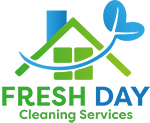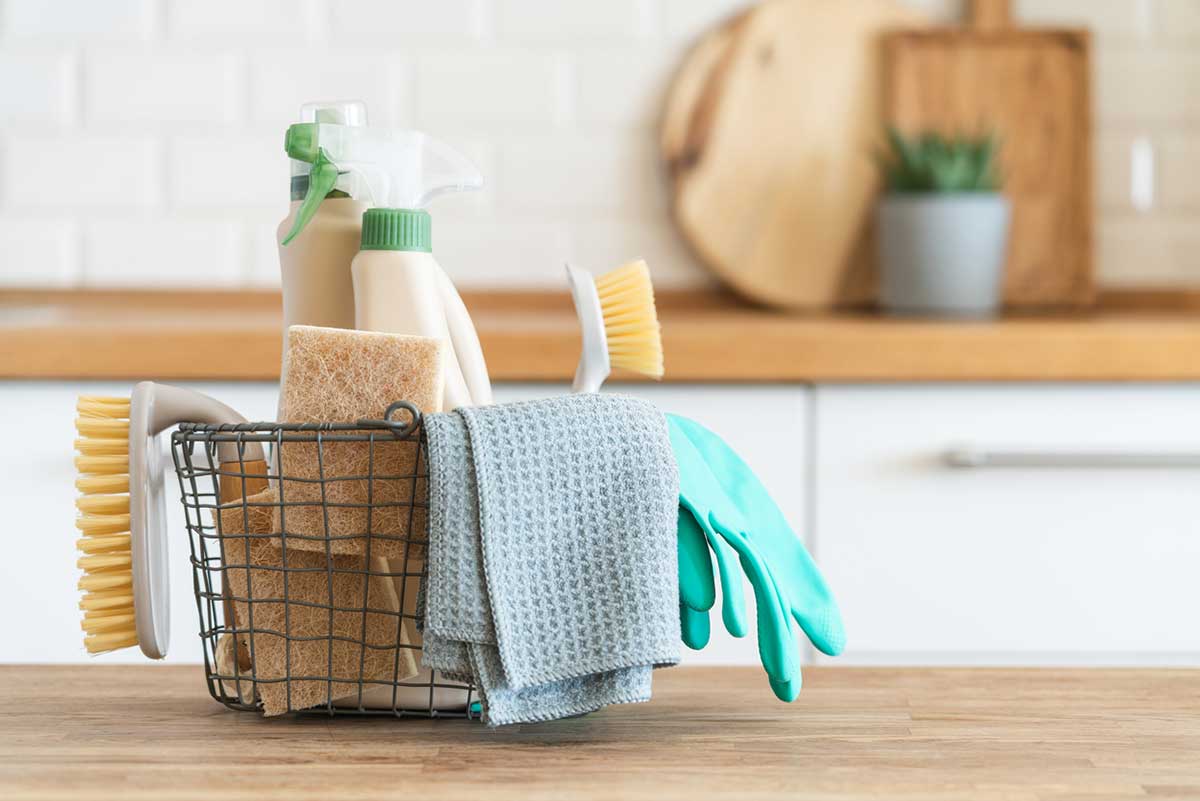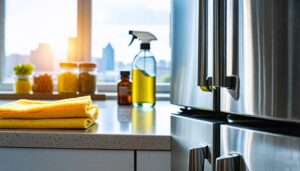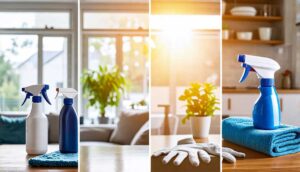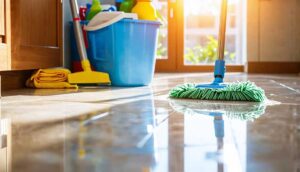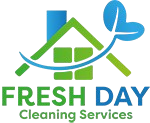Non-toxic residential cleaning methods prioritize health and environmental sustainability. These approaches utilize natural ingredients like white vinegar, baking soda, and essential oils to create effective cleaning solutions. DIY recipes and eco-friendly tools, such as microfiber cloths and steam mops, improve cleaning efficacy while minimizing chemical exposure. Adopting these methods enhances indoor air quality, reduces respiratory issues, and mitigates long-term health risks associated with conventional cleaners. Room-specific techniques guarantee thorough cleaning throughout the home. To avoid greenwashing, consumers should scrutinize ingredient lists and look for reputable certifications like EPA Safer Choice. Shifting to non-toxic cleaning practices offers numerous benefits for both personal well-being and ecological preservation.
Health Benefits of Non-Toxic Cleaning
The air we breathe indoors plays an essential role in our overall health and well-being. Studies show that indoor air quality is often 2-3 times worse than outdoor air, emphasizing the need for effective, non-toxic cleaning methods. Non-toxic cleaning products significantly improve indoor air quality, reducing the risk of respiratory issues and allergies.
Conventional cleaning products often contain toxic ingredients linked to serious health concerns, including asthma, skin reactions, and even cancer. By choosing safer alternatives, households can avoid exposure to harmful fumes and irritants, creating a healthier living environment. This is particularly beneficial for families with children or individuals with sensitivities.
Research indicates that exposure to conventional cleaning chemicals can disrupt immune system development and impact skin and oral health. Non-toxic cleaning products help mitigate these risks, promoting overall health and wellness. Additionally, these safer options are often more cost-effective in the long term, as they reduce potential health-related expenses and support sustainability through biodegradable materials and reduced environmental impact. By prioritizing non-toxic cleaning methods, individuals can protect their health while contributing to a cleaner, more sustainable future.
Essential Natural Cleaning Ingredients
Natural cleaning ingredients offer potent solutions for household sanitization without harmful chemicals. White vinegar’s versatility and antibacterial properties make it an essential component in non-toxic cleaning regimens, effectively tackling hard water stains on various surfaces. Baking soda’s mild abrasive nature and deodorizing capabilities provide an eco-friendly alternative for scrubbing tough stains, while essential oils contribute antimicrobial benefits and pleasant aromas to homemade cleaning solutions.
Vinegar’s Versatile Cleaning Power
Among the vital natural cleaning ingredients, vinegar stands out as a powerhouse of versatility and effectiveness. This eco-friendly cleaning agent boasts remarkable disinfectant properties, efficiently eliminating bacteria from various surfaces. When formulating cleaning solutions, a 1:4 ratio of vinegar to water creates an ideal mixture for achieving streak-free results on glass and mirrors, offering a chemical-free alternative to conventional cleaners.
Vinegar’s acidic composition makes it particularly adept at dissolving mineral deposits and hard water stains, rejuvenating faucets and showerheads. Its ability to neutralize odors further improves its utility, making it an excellent choice for deodorizing refrigerators and trash receptacles. These attributes position vinegar as a cornerstone of non-toxic cleaning regimens, promoting healthier living environments while reducing reliance on harsh chemicals.
However, it is important to exercise caution when using vinegar-based cleaning solutions. Natural stone surfaces, such as marble and granite, are susceptible to etching and damage from vinegar’s acidity. By understanding vinegar’s strengths and limitations, homeowners can harness its cleaning power effectively, contributing to more sustainable and health-conscious cleaning practices.
Baking Soda’s Abrasive Properties
Another essential natural cleaning ingredient, baking soda, offers remarkable abrasive properties that make it indispensable for eco-conscious households. This versatile substance, also known as sodium bicarbonate, effectively removes stains and residue from various surfaces without causing scratches. Its mild abrasive nature makes it ideal for cleaning sinks, countertops, and bathroom fixtures, providing a safe alternative to harsh chemical cleaners.
Baking soda’s efficacy extends beyond its abrasive qualities. When combined with water, it forms a paste that can tackle stubborn stains on grout and in ovens. This natural cleaning product also possesses deodorizing properties, neutralizing odors in carpets, upholstery, and refrigerators, thereby promoting a fresher indoor environment. As an eco-friendly option, baking soda minimizes health risks associated with toxic chemicals found in commercial cleaning products, making it safe for use around children and pets. Its versatility further extends to laundry applications, where it can improve detergent performance and whiten clothes. By incorporating baking soda into their cleaning routines, environmentally-conscious individuals can maintain a clean home while reducing their reliance on potentially harmful synthetic cleaning agents.
Essential Oils’ Antimicrobial Benefits
Within the domain of non-toxic cleaning methods, essential oils stand out as potent antimicrobial agents, offering a natural alternative to synthetic disinfectants. Research demonstrates the efficacy of these botanical extracts in combating harmful microorganisms, with tea tree oil, in particular, exhibiting the ability to reduce pathogen effectiveness by up to 99.9% in cleaning products. This remarkable disinfectant capacity underscores the potential of essential oils in creating safer, more environmentally-friendly cleaning solutions.
Lavender, eucalyptus, and lemon essential oils further expand the antimicrobial arsenal available for non-toxic cleaning. These oils not only impart pleasant fragrances but also demonstrate significant antibacterial and antiviral properties. When incorporated into DIY cleaning recipes or commercial formulations, they improve the overall germ-fighting capabilities of the products while maintaining a chemical-free approach.
The integration of essential oils into cleaning routines represents a scientifically-backed strategy for maintaining a hygienic living environment without relying on harsh synthetic compounds. By harnessing the natural antimicrobial properties of these botanical extracts, individuals can effectively sanitize their living spaces while simultaneously promoting a healthier indoor atmosphere and reducing their environmental impact.
DIY Non-Toxic Cleaning Solutions
Creating your own non-toxic cleaning solutions can significantly reduce exposure to harmful chemicals while effectively maintaining a clean and healthy home environment. These DIY green cleaning products offer a safe alternative to commercial cleaners, utilizing simple ingredients readily available in most households.
A versatile multipurpose cleaner can be made by combining Castile soap and water, with optional essential oils for fragrance and antimicrobial properties. This solution is safe for most surfaces and provides effective cleaning power. For disinfection, diluted hydrogen peroxide serves as an eco-friendly substitute for bleach, suitable for cutting boards, refrigerators, and produce.
White vinegar, a potent disinfectant and deodorizer, proves invaluable for cleaning various surfaces, though it should be avoided on natural stones. A homemade laundry detergent can be crafted using Castile soap and vinegar, offering a non-toxic alternative to conventional products.
Baking soda, when combined with vinegar, creates a powerful, fizzing reaction that tackles stubborn stains and odors. This eco-friendly mixture is particularly effective for tough cleaning tasks. By incorporating these simple, non-toxic cleaning solutions into daily routines, homeowners can maintain a clean living space while minimizing environmental impact and potential health risks associated with harsh chemicals.
Effective Green Cleaning Techniques
Implementing effective green cleaning techniques boosts the efficiency of non-toxic cleaning methods while minimizing environmental impact. One such technique is the use of steam mops, which harness the power of water and heat to eliminate dirt and germs without relying on chemical cleaners. This method is particularly effective for floor cleaning and reduces the need for harsh cleaning products.
Another green cleaning technique involves creating multipurpose cleaners using non-toxic ingredients. A solution of Castile soap and water serves as a versatile cleaner for various surfaces. Likewise, hydrogen peroxide acts as a potent disinfectant, comparable to bleach but without harmful side effects, making it ideal for sanitizing cutting boards and refrigerator interiors.
Diluted white vinegar is an effective antibacterial agent and deodorizer, suitable for cleaning sinks, toilets, and removing carpet stains. However, caution should be exercised when using it on natural stone surfaces. Incorporating non-toxic cleaning ingredients like baking soda and essential oils can improve the effectiveness of homemade cleaning solutions. These green cleaning techniques not only provide a healthier alternative to conventional products but also contribute to a more sustainable and eco-friendly approach to household cleaning.
Room-by-Room Non-Toxic Cleaning Guide
The room-by-room approach to non-toxic cleaning optimizes the use of green techniques and natural ingredients for specific household areas. In the kitchen, a mixture of distilled white vinegar and baking soda effectively removes grease and odors from countertops and sinks without relying on harmful chemicals. Bathroom cleaning methods utilize a paste of baking soda and hydrogen peroxide as a natural disinfectant for tiles and grout, eliminating the need for toxic conventional cleaners.
Living areas benefit from microfiber cloths paired with a simple solution of water and castile soap, reducing reliance on chemical sprays for dusting. Bedrooms require regular vacuuming with HEPA filters to trap allergens and improve air quality. Non-toxic cleaning products for bedding include homemade laundry detergent made from castile soap, ensuring freshness without harsh chemicals.
Window cleaning achieves a streak-free shine using equal parts distilled white vinegar and water, applied with microfiber cloths. This method replaces ammonia-based or synthetic cleaners. By implementing these room-specific, non-toxic cleaning methods, homeowners can maintain a clean and healthy living environment while minimizing exposure to potentially harmful substances.
Eco-Friendly Cleaning Tools
At Fresh Day Cleaning Services, we take pride in using the same eco-friendly tools and methods for our customers in Catonsville, MD. Our dedication to non-toxic residential cleaning reflects our commitment to both sustainability and the health of your home. By incorporating microfiber cloths, which efficiently trap dust and dirt without the need for harsh chemicals, and glass spray bottles for homemade, non-toxic cleaning solutions, we significantly reduce chemical use and plastic waste during each cleaning session.
We also utilize biodegradable buckets and natural fiber scouring pads and scrub brushes to ensure your floors and surfaces are thoroughly cleaned without introducing harmful chemicals into your living space. For enhanced indoor air quality, our Dyson HEPA vacuums capture allergens and pollutants, making your home not only cleaner but also healthier. Our eco-conscious approach guarantees that your home is treated with care, ensuring a spotless and safe environment for you and your family.
Avoiding Greenwashing in Cleaning Products
In the quest for non-toxic cleaning methods, consumers must navigate the complex landscape of greenwashing in cleaning products. Identifying misleading eco-labels requires a critical eye and knowledge of reputable certifications, such as those from the Environmental Working Group (EWG) or other recognized third-party organizations. Scrutinizing ingredient lists and researching brand transparency are essential steps in distinguishing genuinely eco-friendly products from those making unsubstantiated or exaggerated environmental claims.
Identifying Misleading Eco-Labels
Eco-label confusion presents a significant challenge for consumers seeking genuinely non-toxic cleaning products. The widespread use of ambiguous terms like “natural” and “eco-friendly” on cleaning product labels often obscures the true nature of their ingredients. To navigate this complex landscape, consumers must adopt a critical approach when evaluating product claims.
One effective strategy is to utilize resources like the Think Dirty app, which provides detailed information on potentially harmful ingredients in cleaning products. This tool can help identify toxic ingredients and highlight truly non-toxic alternatives. Additionally, seeking out certifications from reputable organizations, such as the EPA’s Safer Choice label, offers assurance that products meet stringent safety and environmental standards.
Consumers should be wary of exaggerated claims or misleading imagery on product packaging, as these may indicate greenwashing rather than genuine eco-friendliness. Familiarizing oneself with common harmful ingredients like phthalates and parabens is essential for evaluating product safety. By scrutinizing labels for specific ingredient disclosures and being vigilant against vague terminology, consumers can make informed choices and avoid cleaning products containing harsh chemicals and toxic ingredients.
Research Reputable Certifications
Maneuvering the complex landscape of cleaning product labels requires more than vigilance against misleading terminology. To effectively identify non-toxic cleaning products, consumers must turn to reputable certifications that rigorously evaluate safety and sustainability claims.
Certifications such as the EPA Safer Choice label and Green Seal provide assurance that products meet specific environmental and health standards. These third-party verifications help consumers navigate the often confusing world of eco-friendly claims, reducing the risk of falling prey to greenwashing tactics. Likewise, USDA Organic and EcoLogo certifications indicate that products have undergone stringent testing for safety and sustainability.
For those seeking additional information, the Think Dirty app offers a convenient solution. By scanning product barcodes, consumers can access detailed ingredient safety assessments, empowering them to make informed choices. As the landscape of eco-friendly certifications continues to evolve, staying informed about these standards becomes vital in selecting genuinely non-toxic cleaning products. By prioritizing products with recognized certifications, consumers can confidently choose cleaning solutions that align with their health and environmental values while avoiding potentially harmful greenwashed alternatives.
Scrutinize Ingredient Lists
A product’s ingredient list serves as a essential window into its true composition, often revealing hidden toxins beneath a veneer of eco-friendly marketing. To combat greenwashing in cleaning products, consumers must scrutinize ingredient lists meticulously. This process involves identifying potentially harmful substances such as phthalates, artificial fragrances, and surfactants, which can negatively impact both human health and indoor air quality.
Utilizing resources like the Think Dirty app can significantly aid in this scrutiny. By scanning product barcodes, consumers gain access to detailed ingredient breakdowns and safety ratings, empowering them to make informed decisions. Additionally, seeking out certifications from reputable organizations like the Environmental Working Group (EWG) can provide assurance that products meet higher safety and environmental standards.
However, it’s imperative to remain vigilant, as company ownership changes can affect commitment to non-toxic practices and transparency. Thorough research into brand histories and ingredient sourcing is essential for maintaining a truly non-toxic cleaning regimen. By developing a critical eye for ingredient lists and leveraging available tools, consumers can effectively navigate the complex landscape of cleaning product claims and avoid falling victim to greenwashing tactics.
Transitioning to Non-Toxic Cleaning Habits
Changing to non-toxic cleaning habits represents a significant shift in household management that can yield substantial benefits for both personal health and environmental sustainability. Research demonstrates that moving to non-toxic alternatives can markedly improve indoor air quality by eliminating harmful chemicals associated with respiratory issues and allergies. Additionally, these alternatives may reduce the risk of autoimmune health problems linked to chemical exposure.
Implementing eco-friendly cleaning practices not only safeguards personal well-being but also contributes to environmental conservation. Non-toxic products are typically biodegradable and packaged in recycled materials, minimizing ecological impact. Many households can easily adopt DIY cleaning solutions, such as a multipurpose cleaner made from Castile soap and water, which are both cost-effective and environmentally friendly.
To facilitate the change, resources like the Think Dirty app can help identify harmful ingredients in conventional products and guide consumers toward safer options. By scrutinizing ingredient lists and opting for natural alternatives, individuals can create a healthier living environment while supporting sustainable practices. This shift towards non-toxic cleaning methods represents a holistic approach to household maintenance that prioritizes both human and environmental health.
Frequently Asked Questions
How to Clean Your House Without Toxic Chemicals?
To clean your house without toxic chemicals, opt for eco-friendly products and natural alternatives. Create DIY cleaners using ingredients like Castile soap, white vinegar, hydrogen peroxide, and baking soda. These solutions effectively clean various surfaces while minimizing environmental impact. Diluted vinegar serves as a natural disinfectant, while baking soda acts as a gentle abrasive for tough stains. Utilize steam mops for chemical-free floor cleaning. These methods not only promote a healthier living environment but also reduce exposure to potentially harmful substances.
What Is the Safest Thing to Clean Your House With?
The safest approach to household cleaning involves natural cleaning alternatives and homemade cleaning solutions. White vinegar, baking soda, and Castile soap are non-toxic, effective options for various surfaces. Rubbing alcohol and diluted hydrogen peroxide serve as safe disinfectants. Essential oil cleaners, when used judiciously, can improve cleaning efficacy while providing antimicrobial properties. These eco-friendly methods not only guarantee a clean living environment but also minimize exposure to potentially harmful chemicals, promoting both human and environmental health.
What Is the Least Toxic Home Cleaner?
In the age of chemical wizardry, the least toxic home cleaner harkens back to simpler times. Distilled white vinegar reigns supreme, offering myriad benefits as a natural disinfectant and deodorizer. Its acetic acid content effectively eliminates bacteria and odors without harmful residues. Complementing vinegar’s prowess, baking soda serves as a gentle abrasive for stubborn stains. For improved efficacy and aromatherapeutic properties, essential oils can be judiciously incorporated, creating a synergistic blend that prioritizes both cleanliness and environmental stewardship.
What Are Two Options for Cleaning That Are Less Harmful to the Environment?
Two eco-friendly alternatives for cleaning that reduce environmental impact are DIY cleaners and steam cleaning. Homemade solutions using natural ingredients like white vinegar, baking soda, and castile soap offer effective cleaning power without harmful chemicals. These DIY cleaners are biodegradable and non-toxic. Steam cleaning, utilizing only water and heat, provides a chemical-free method for disinfecting and cleaning surfaces. Both options minimize the use of synthetic substances, promoting a healthier indoor environment and reducing the ecological footprint of household cleaning practices.
